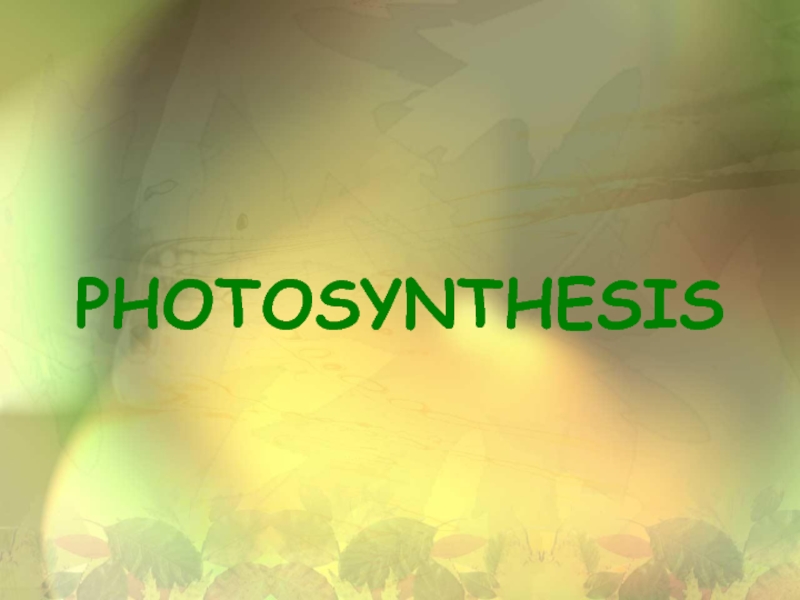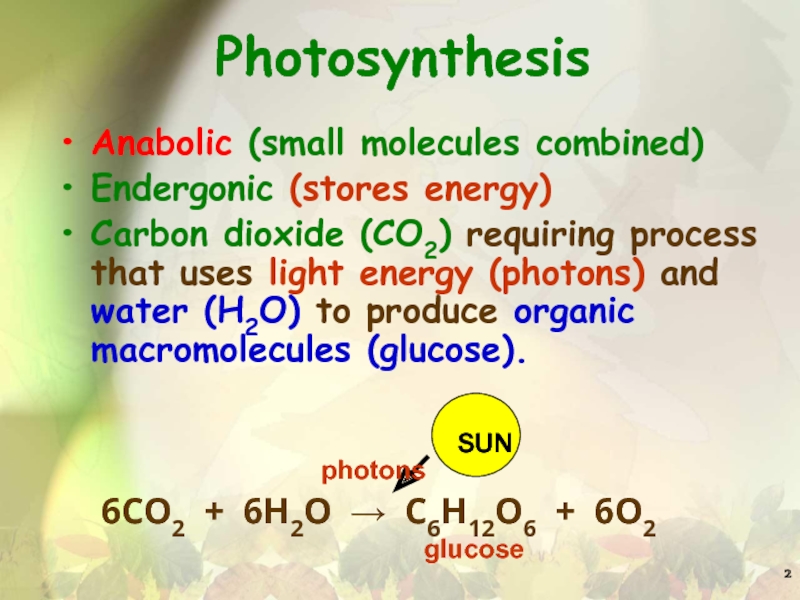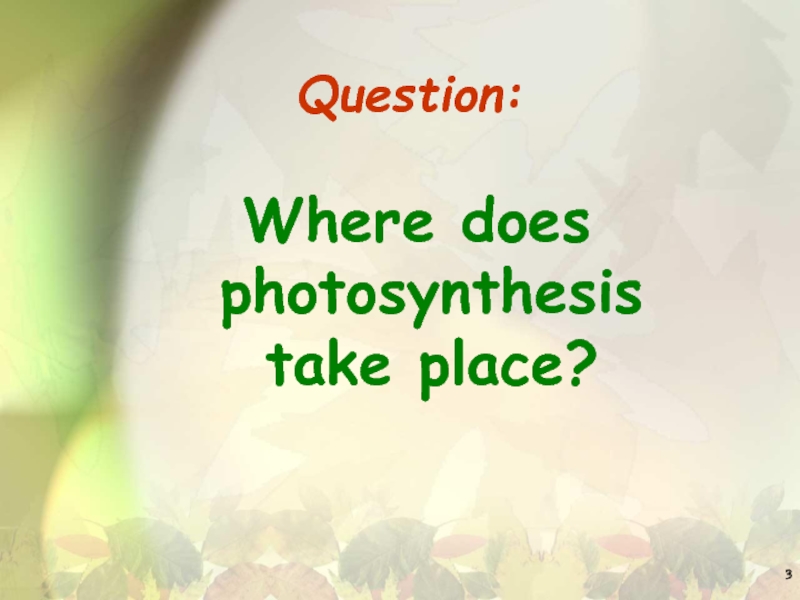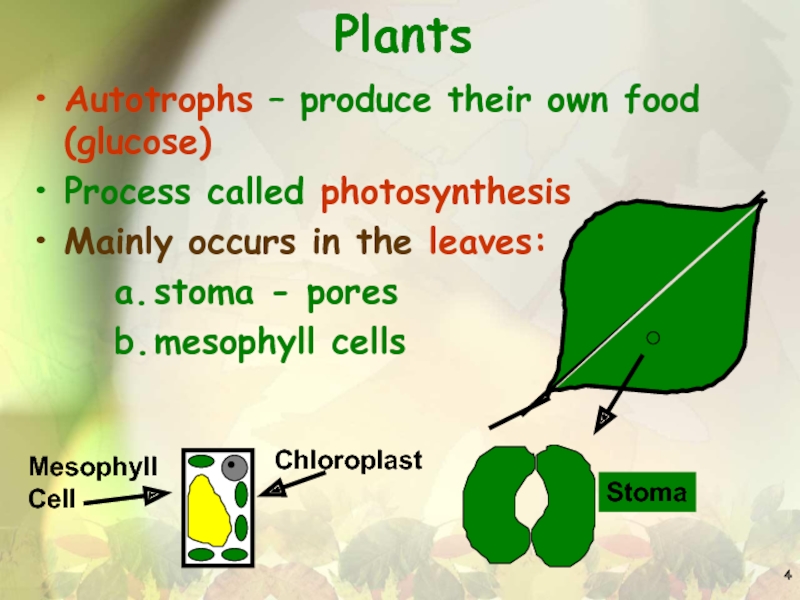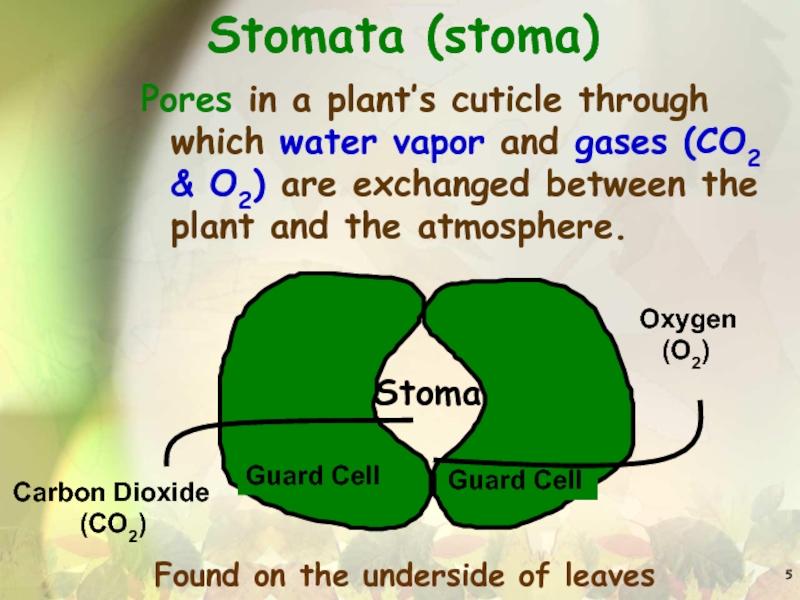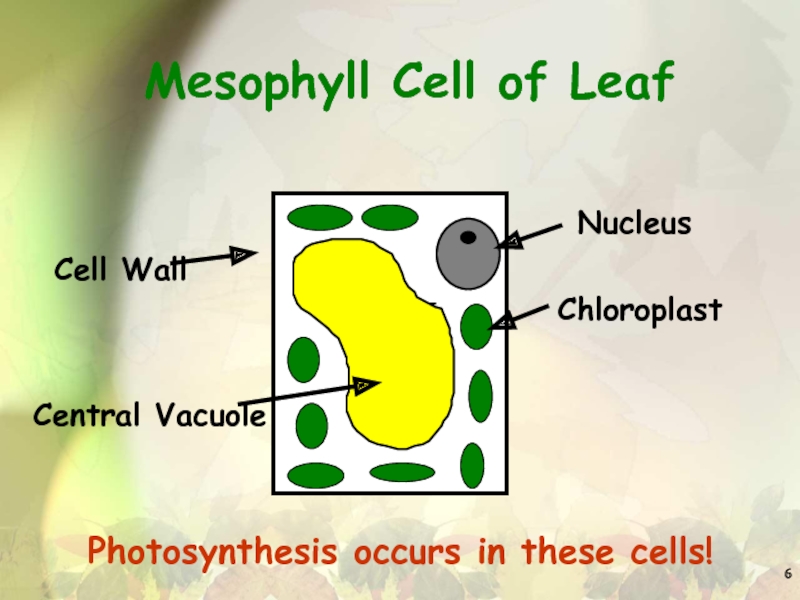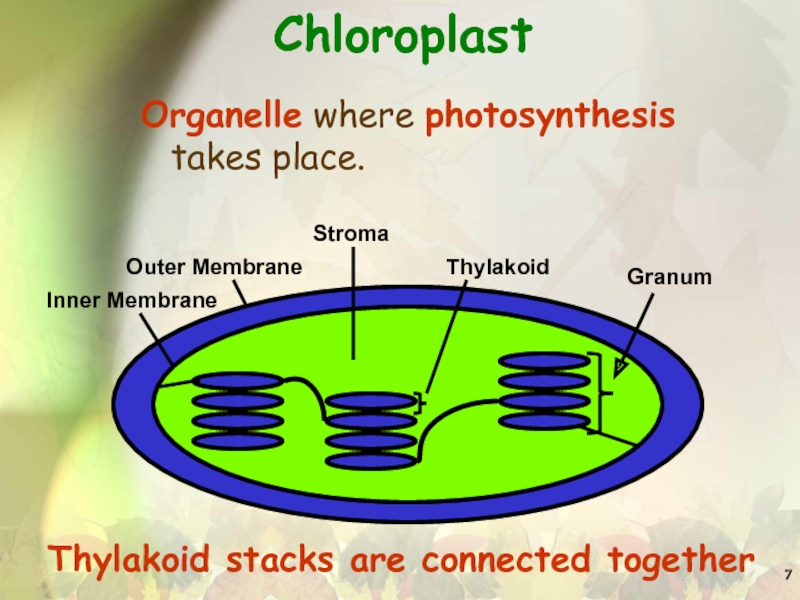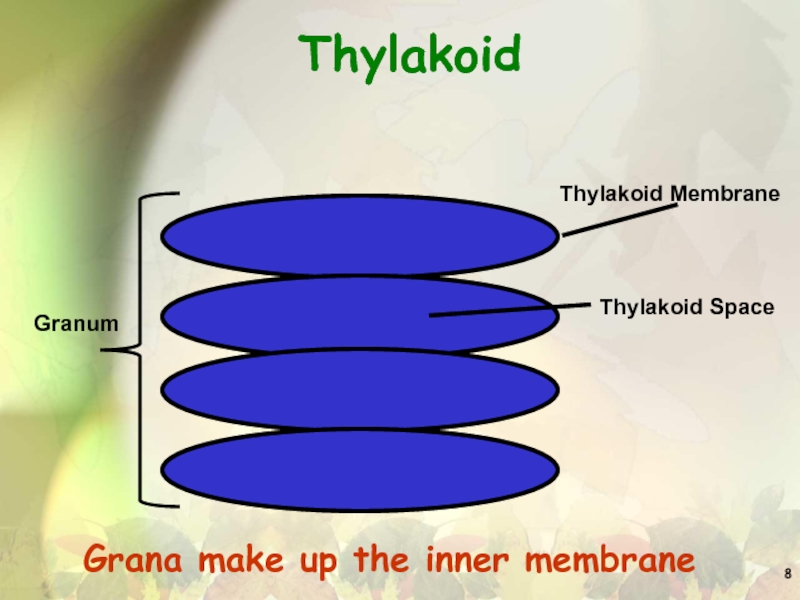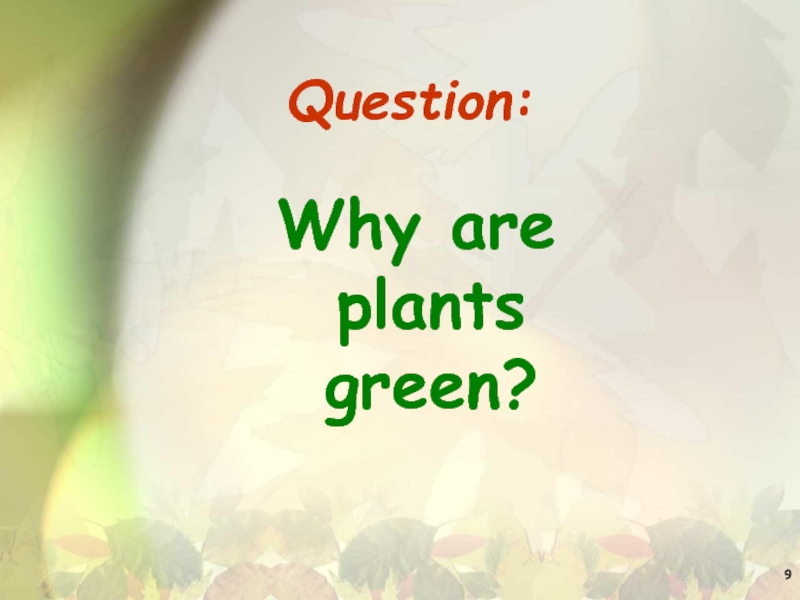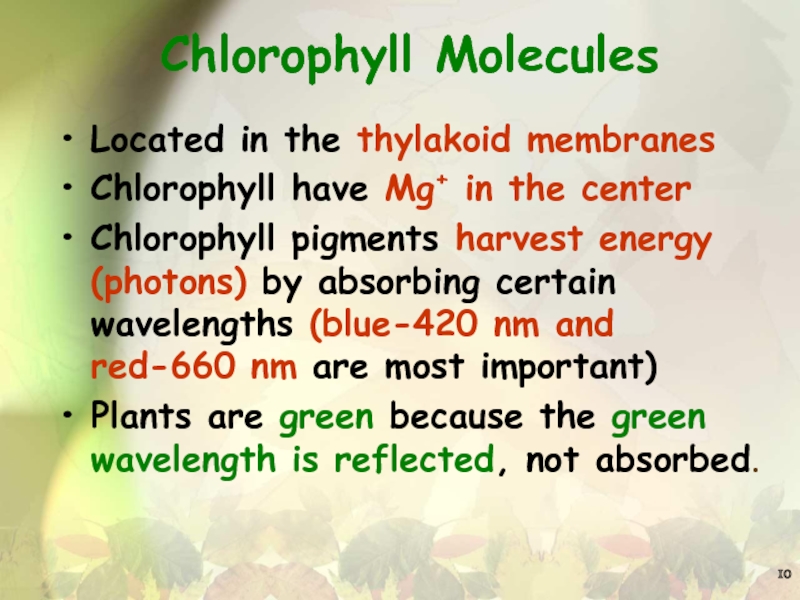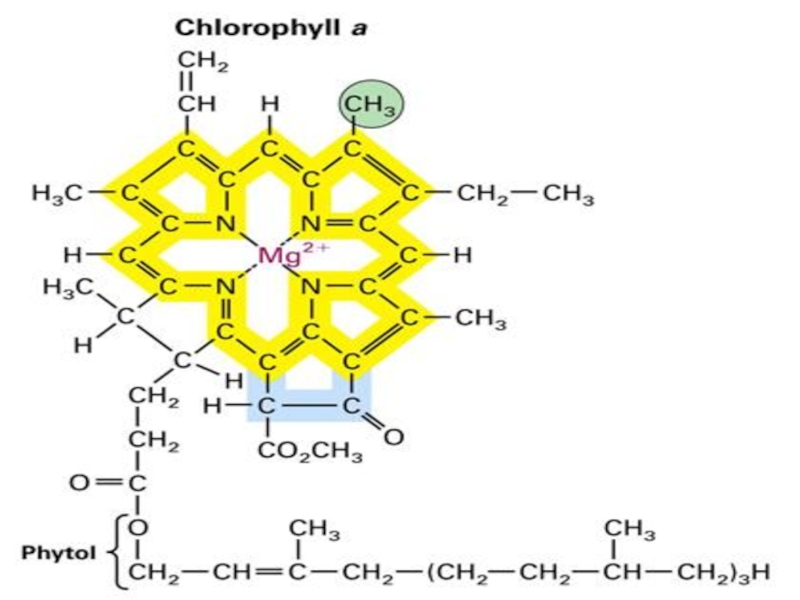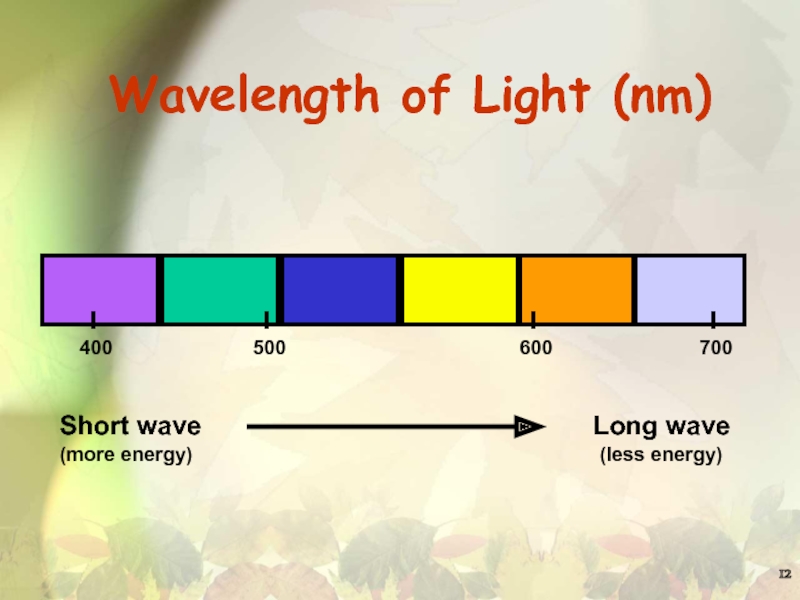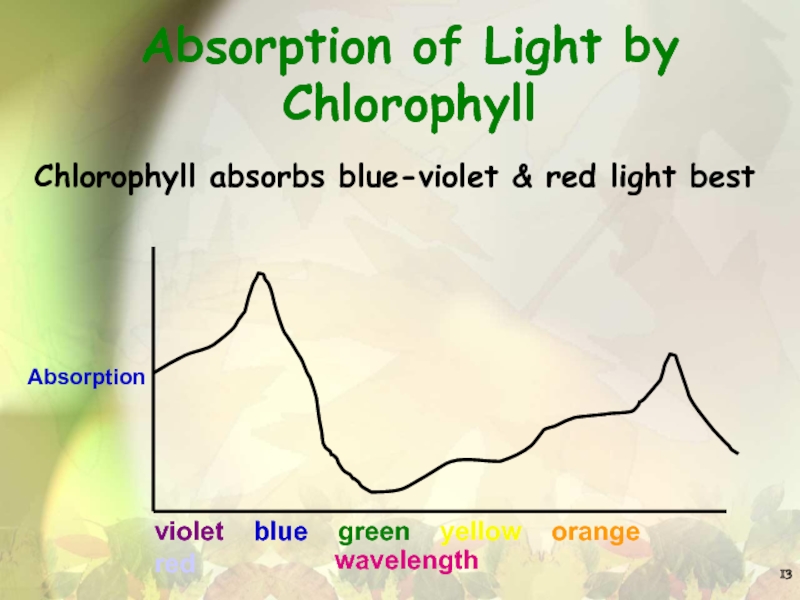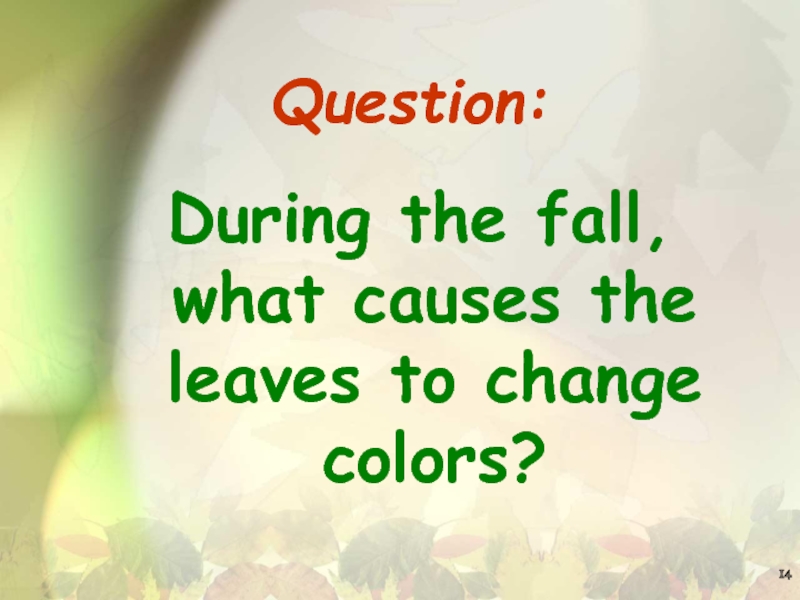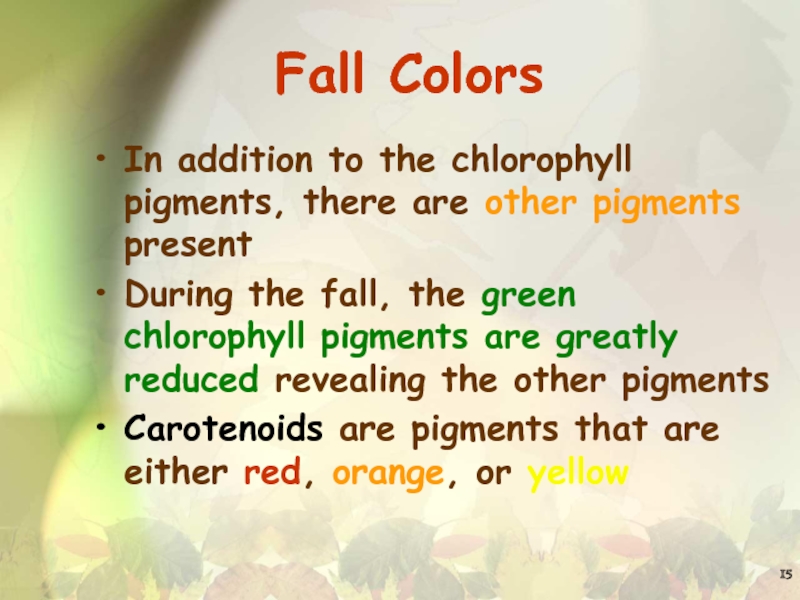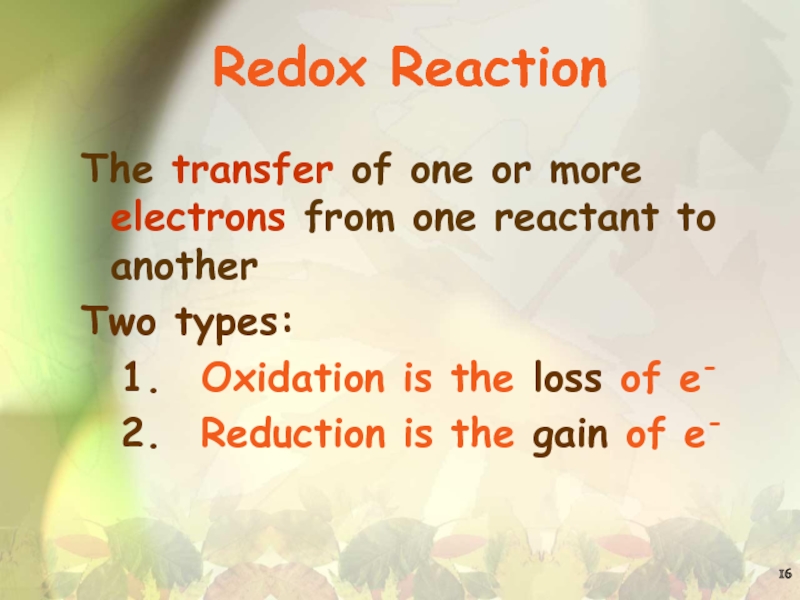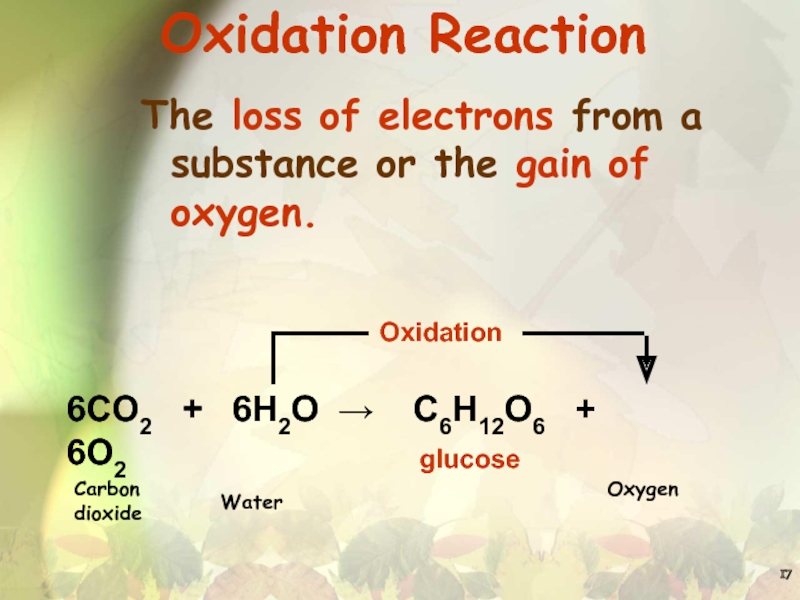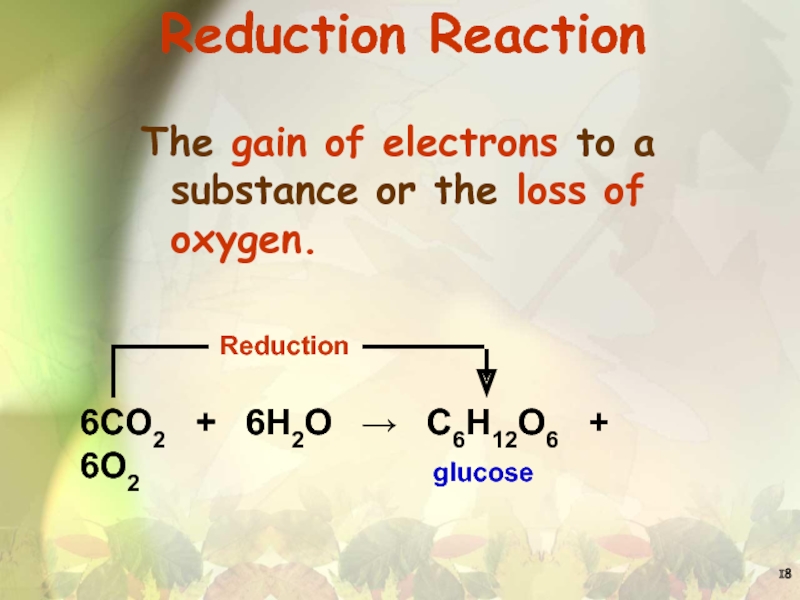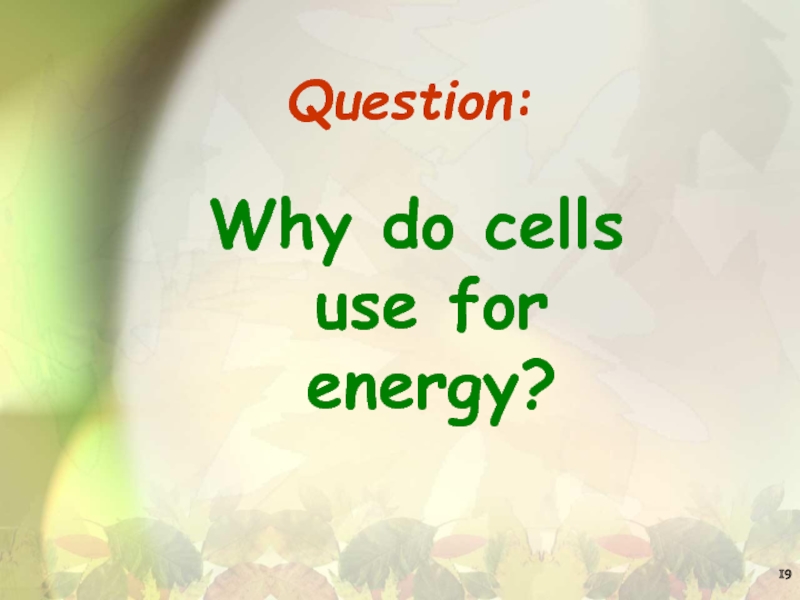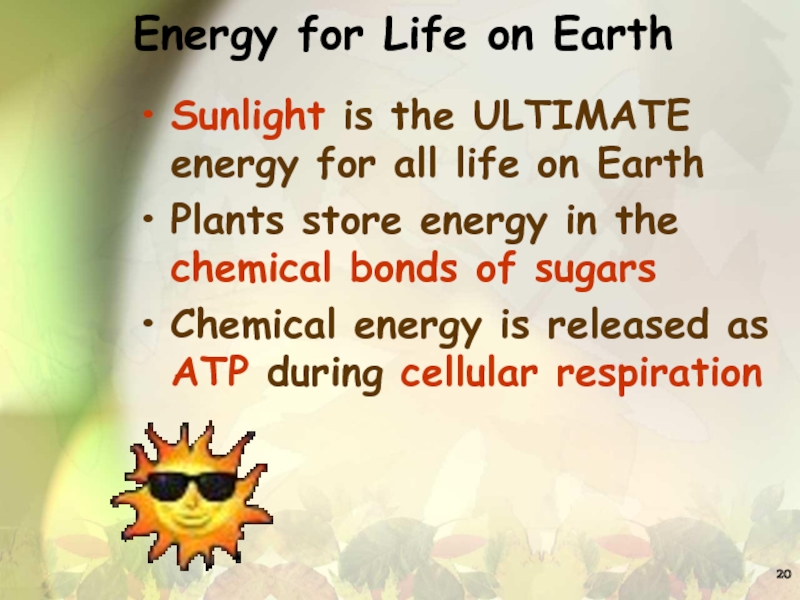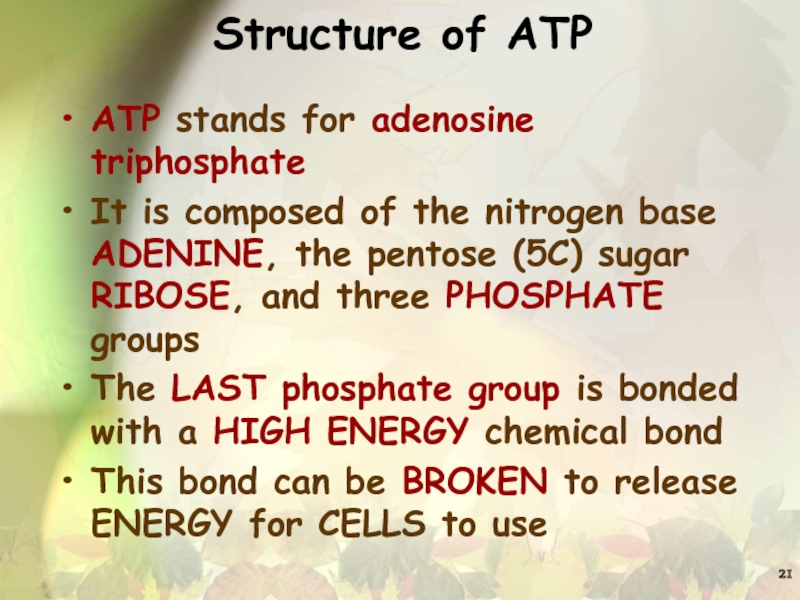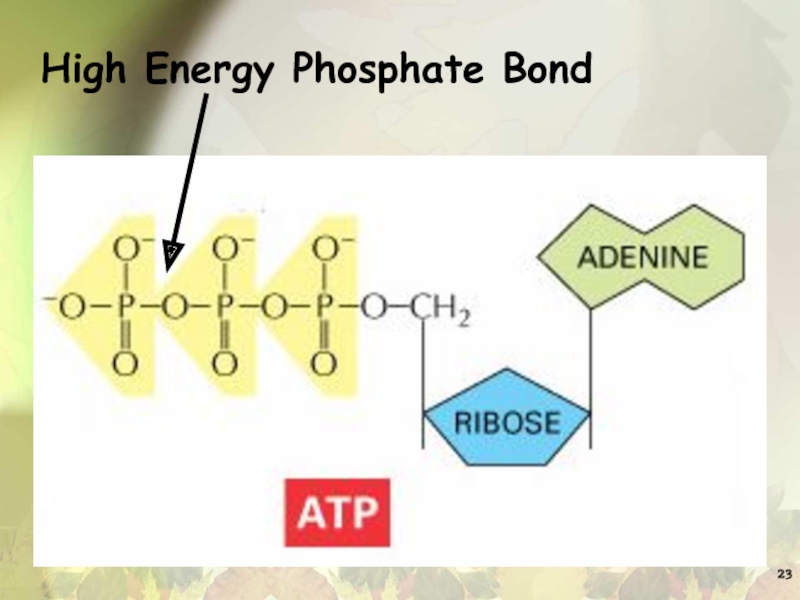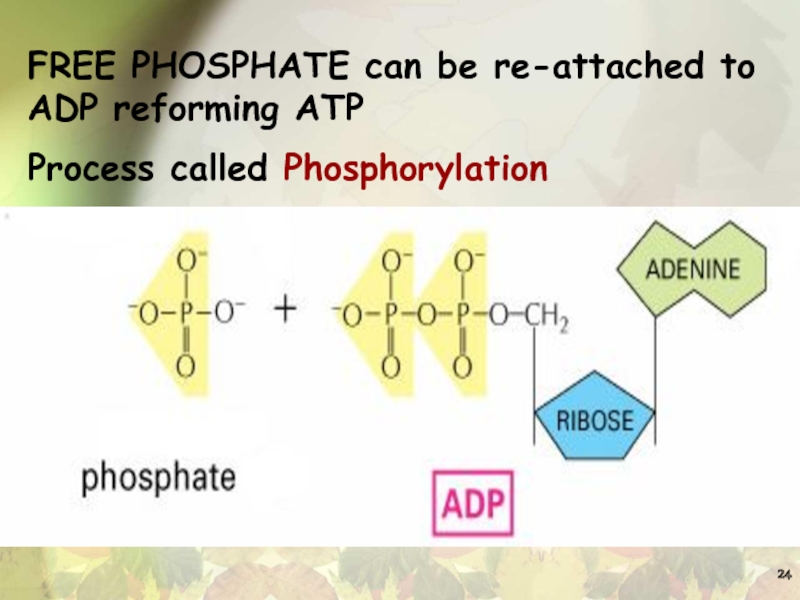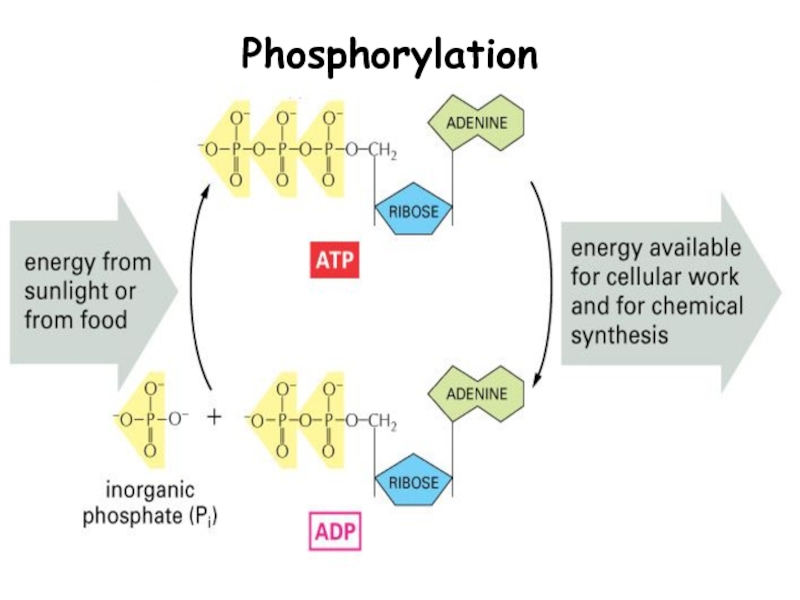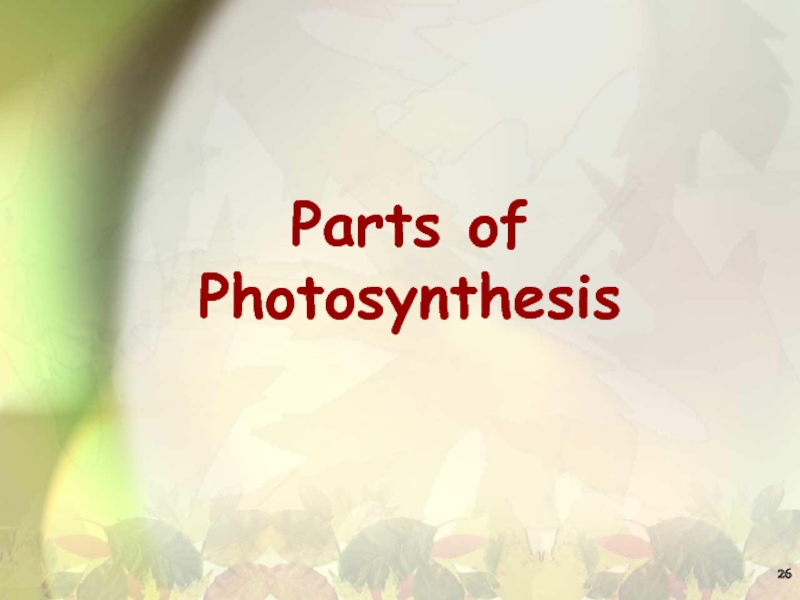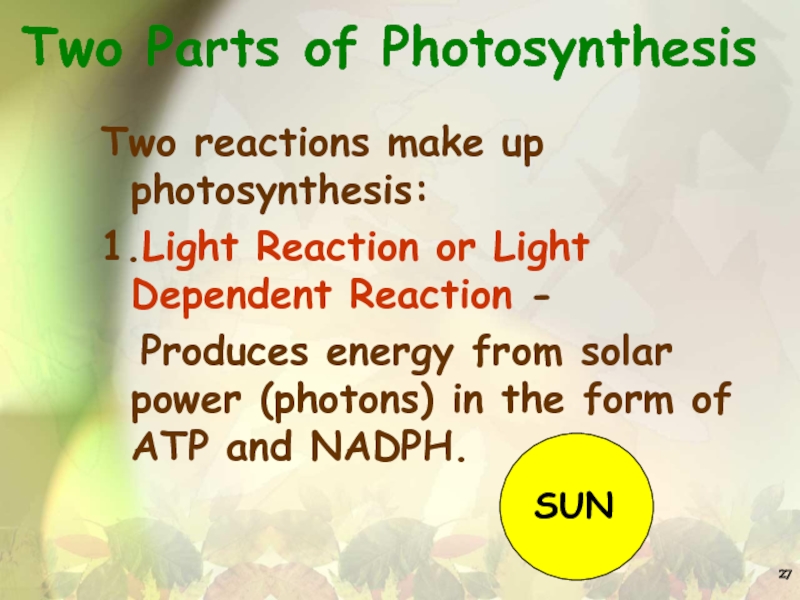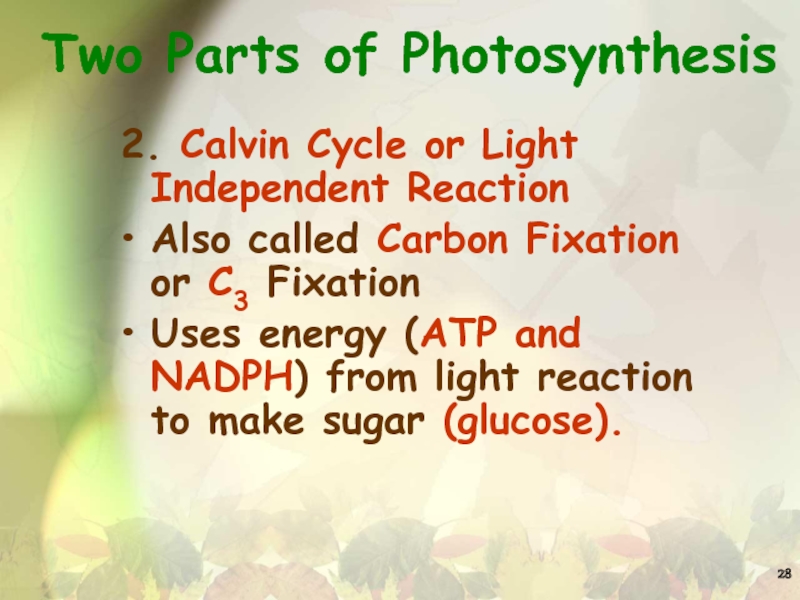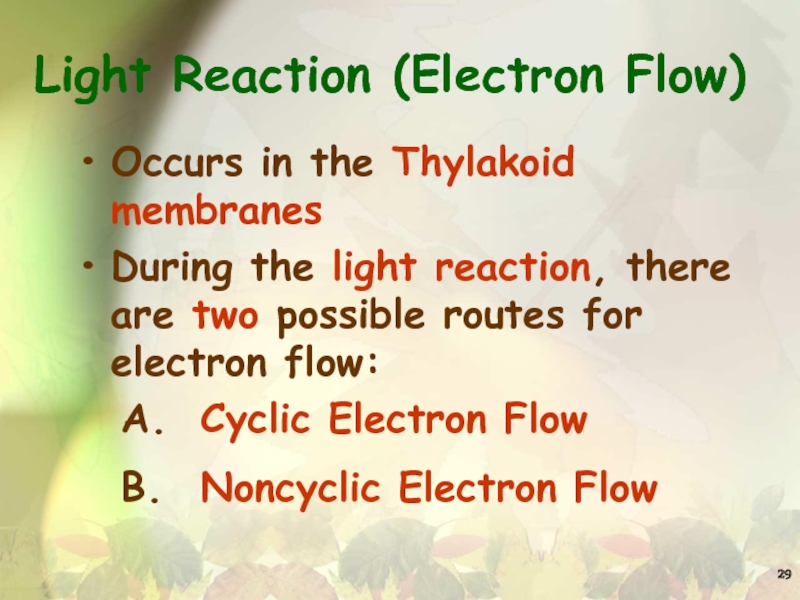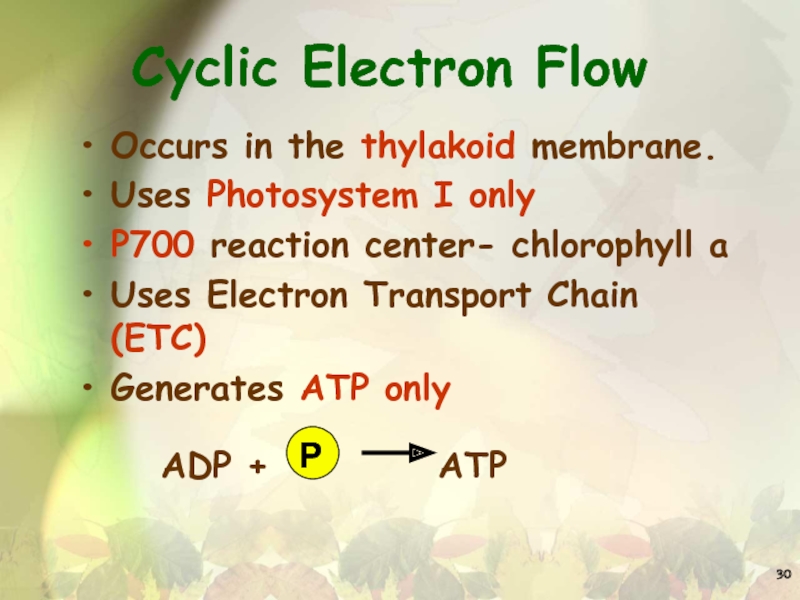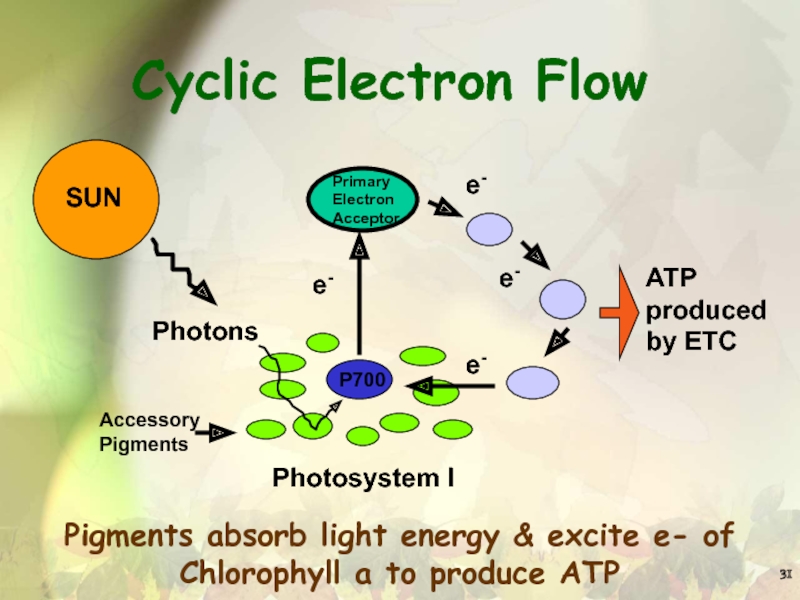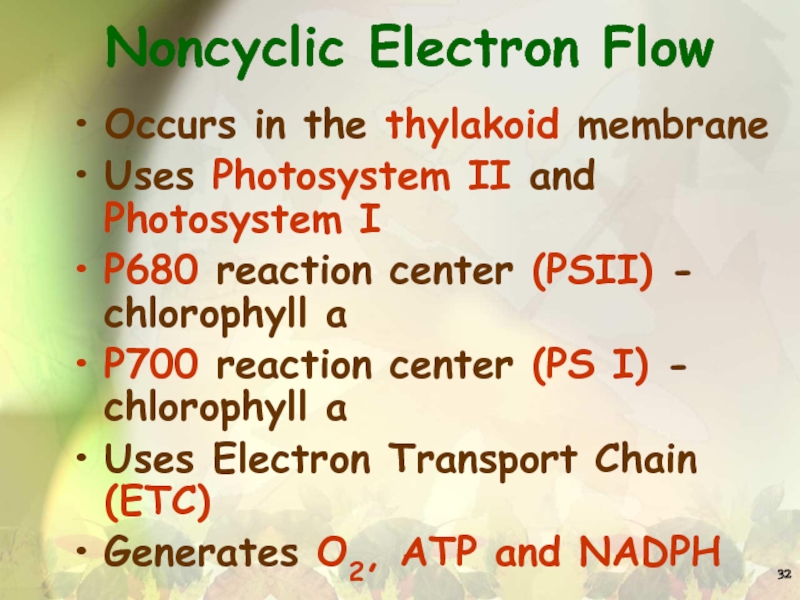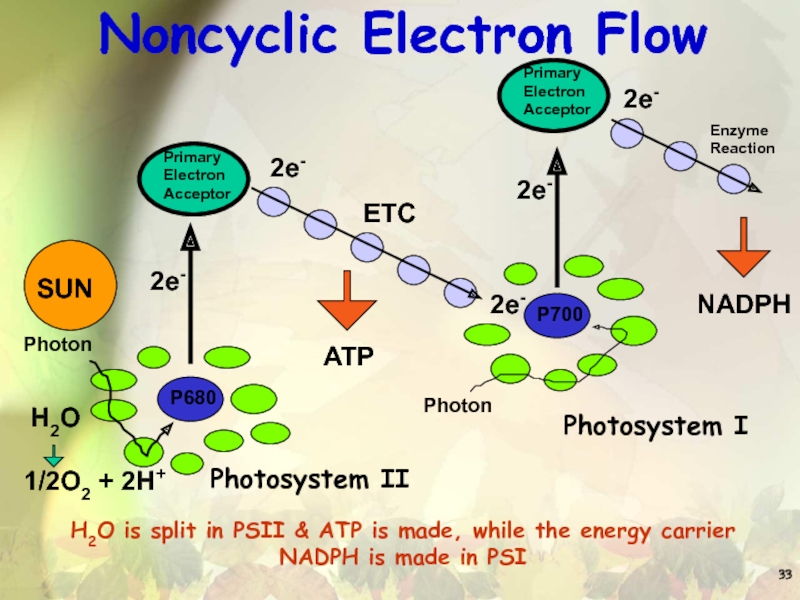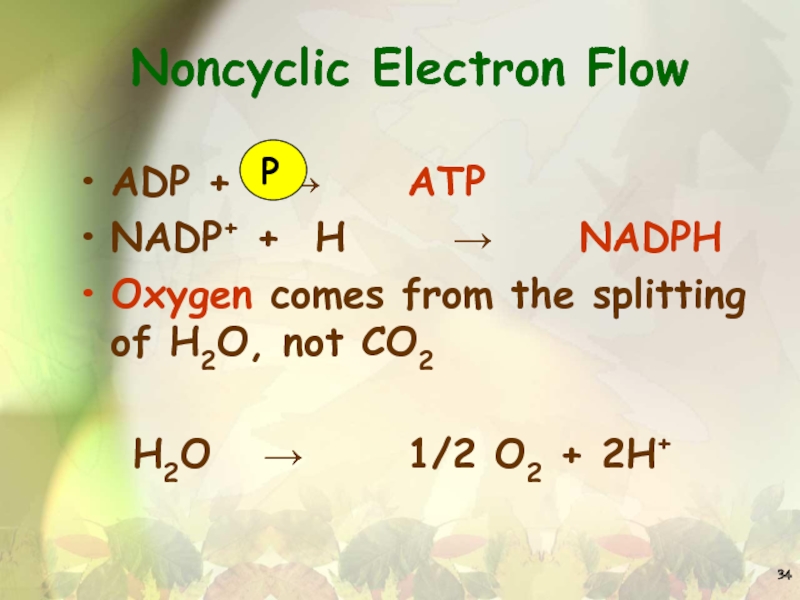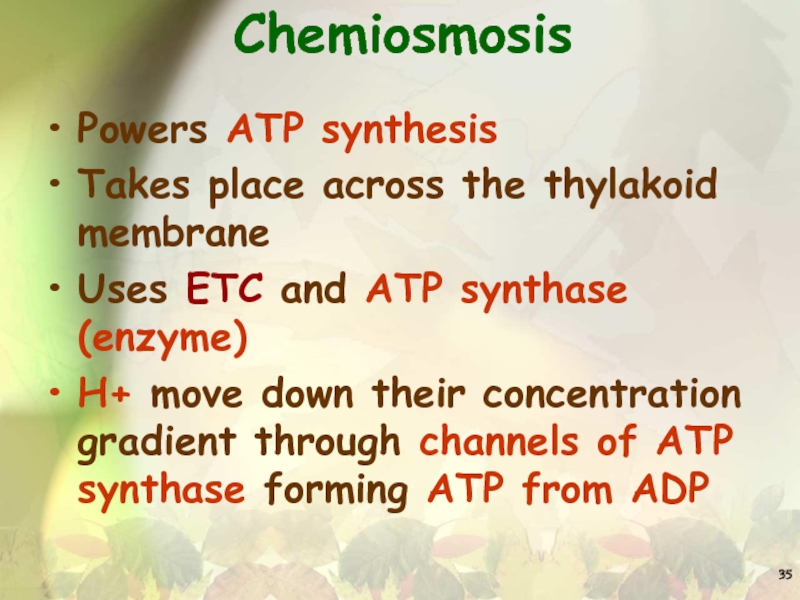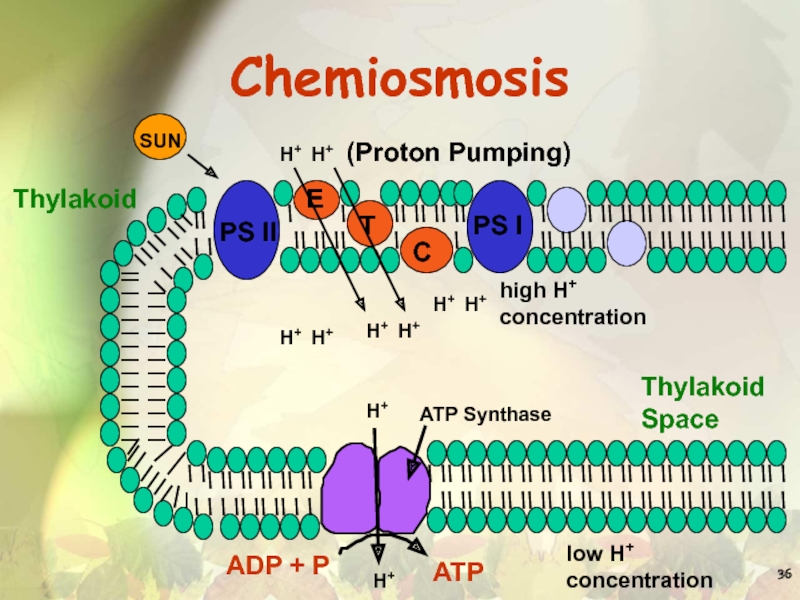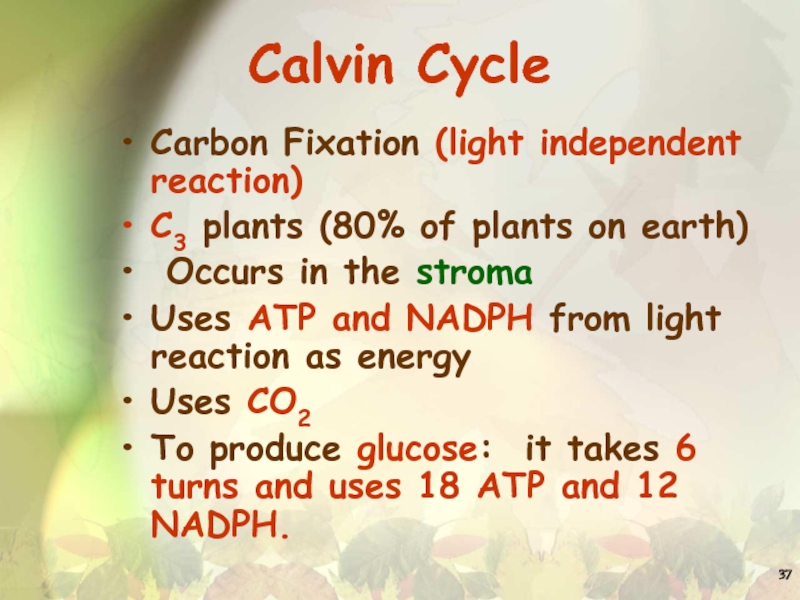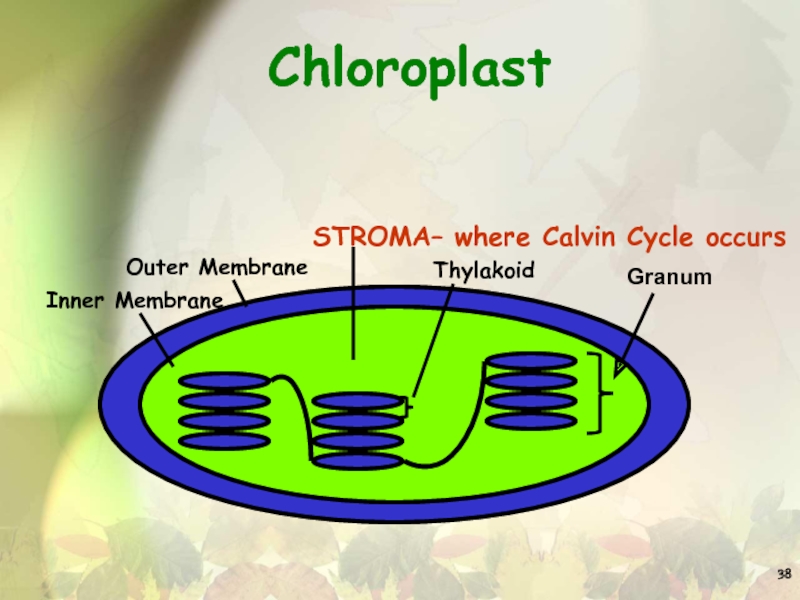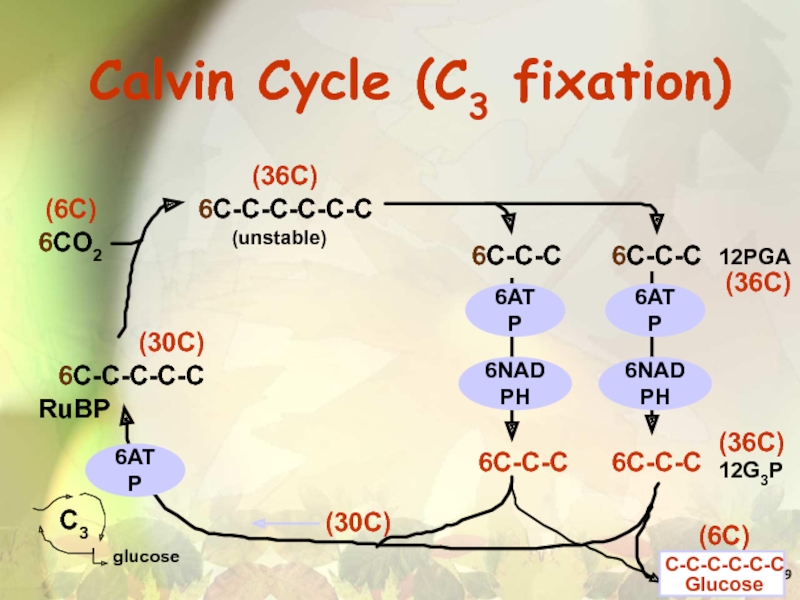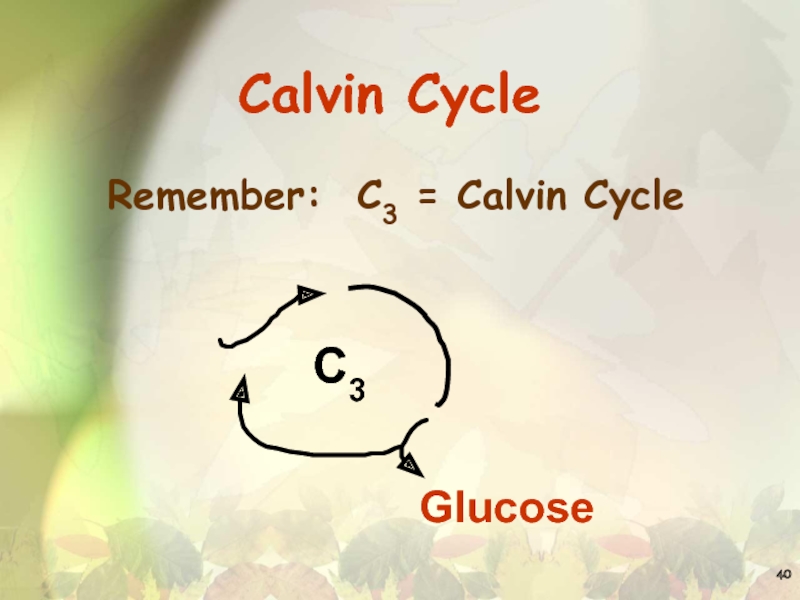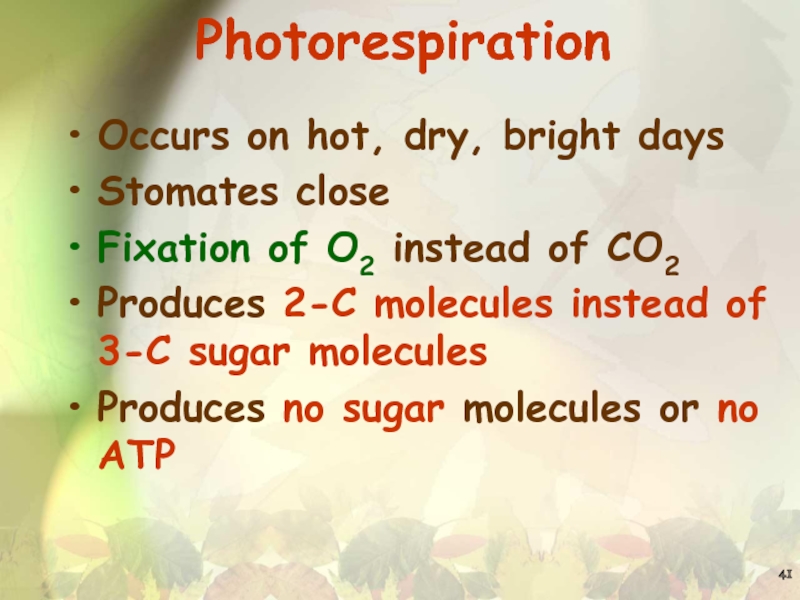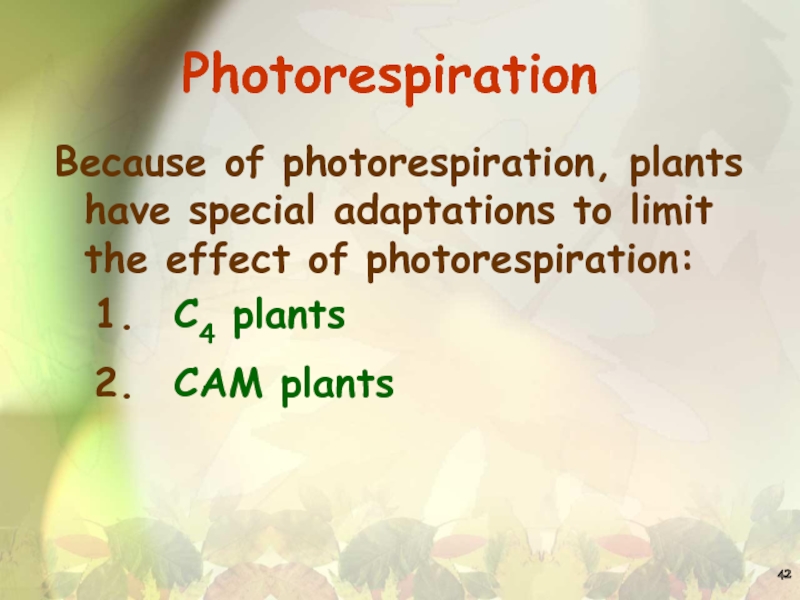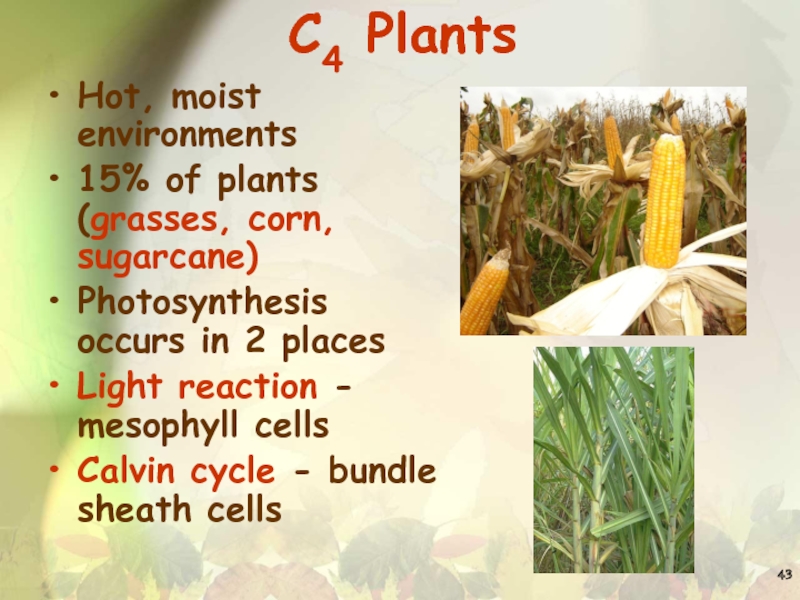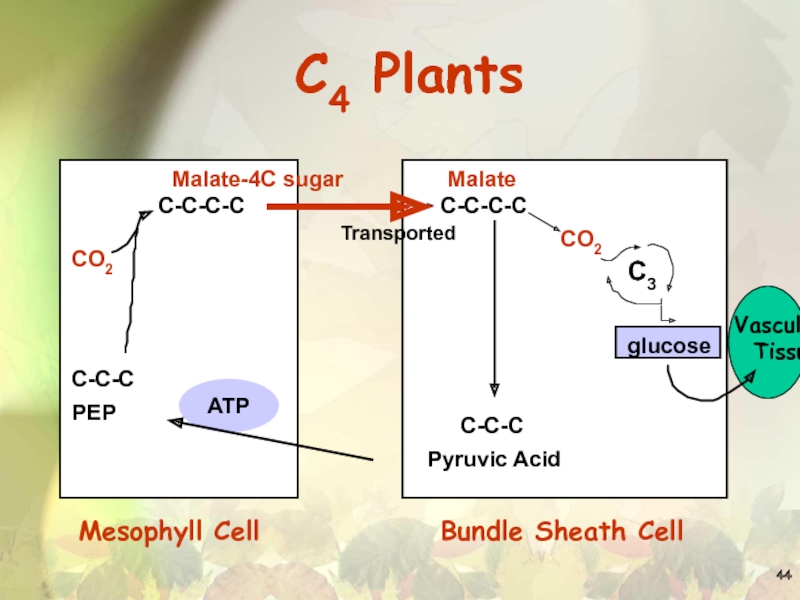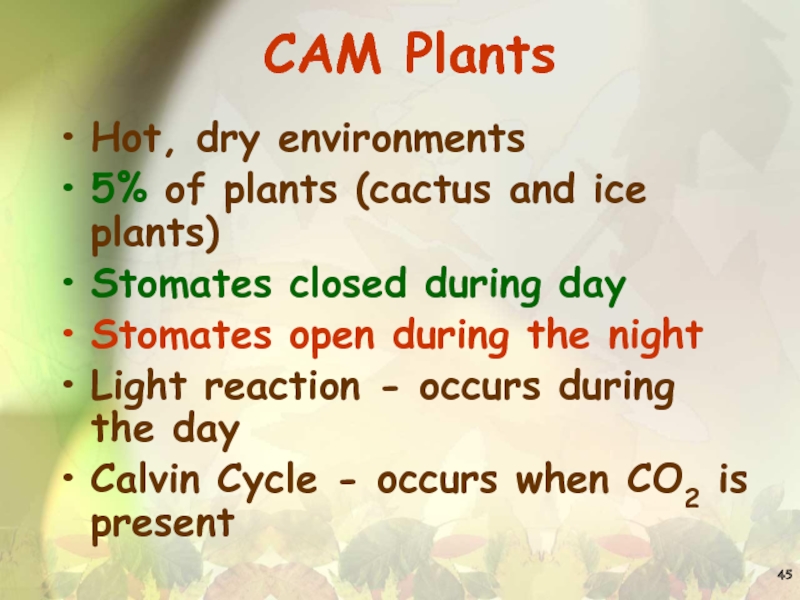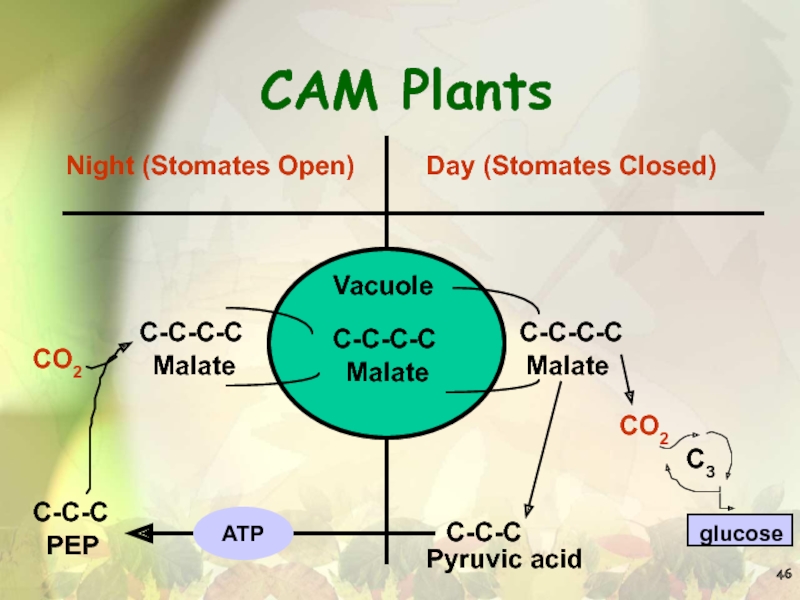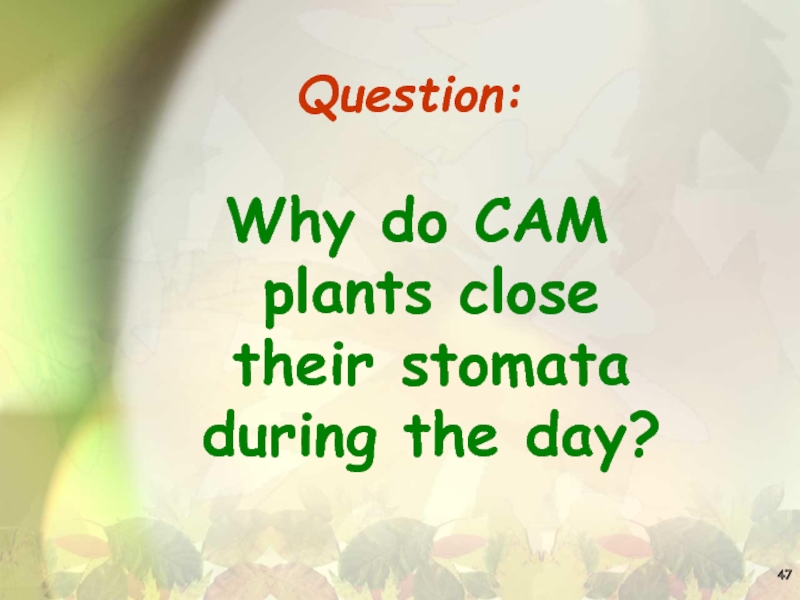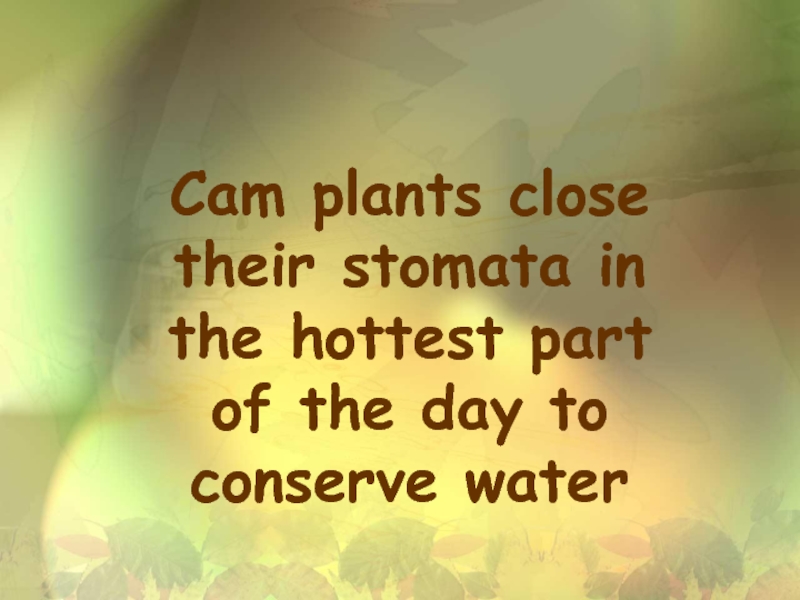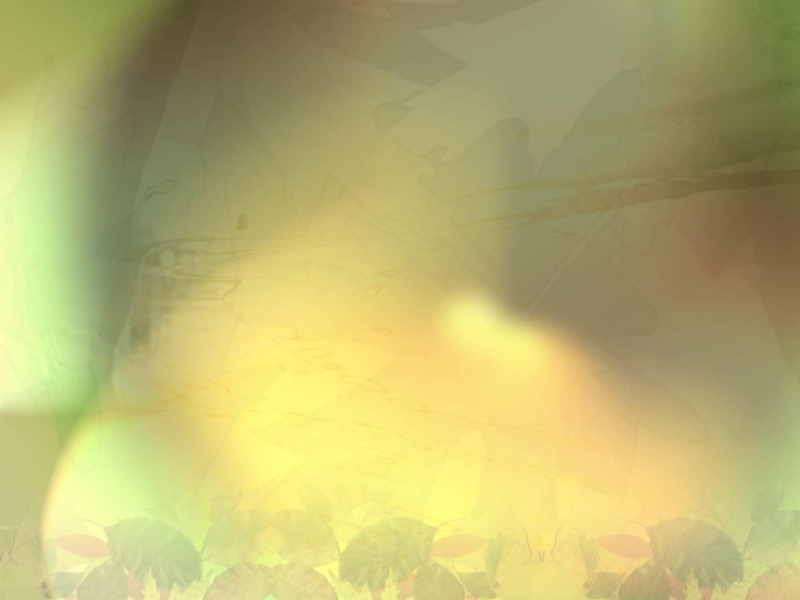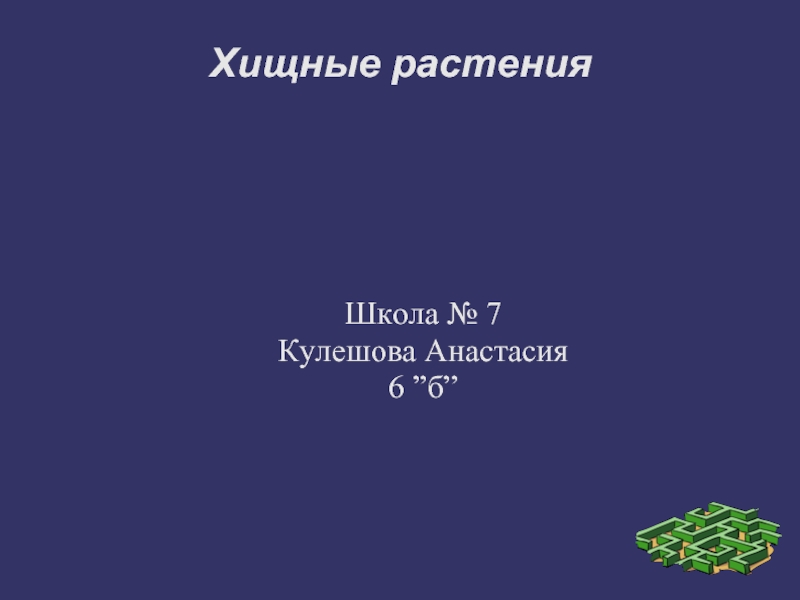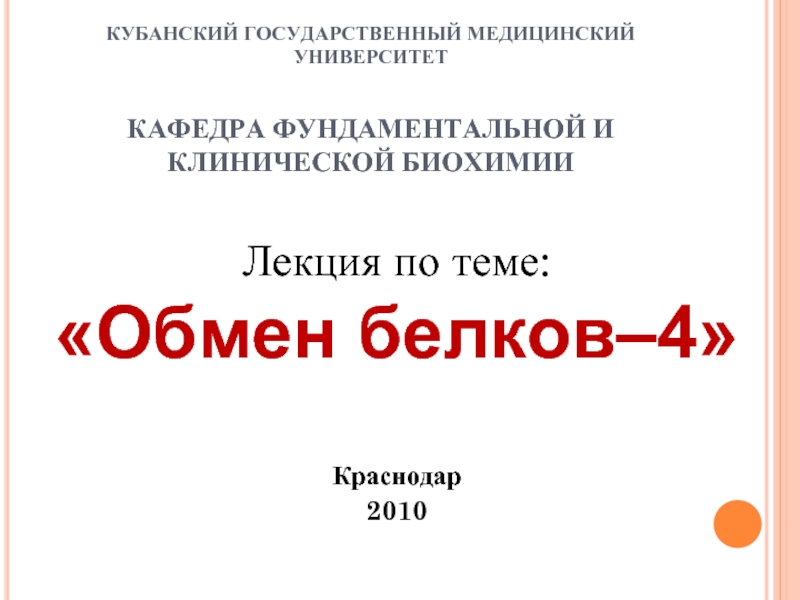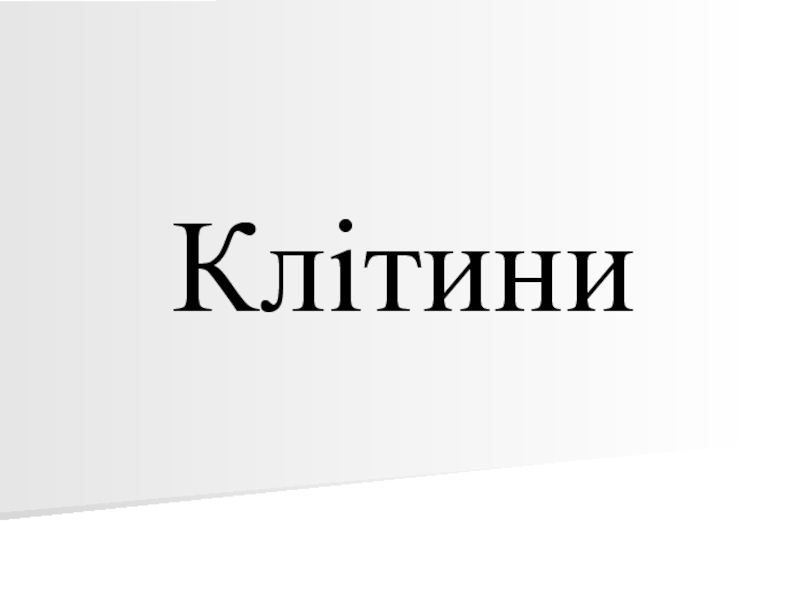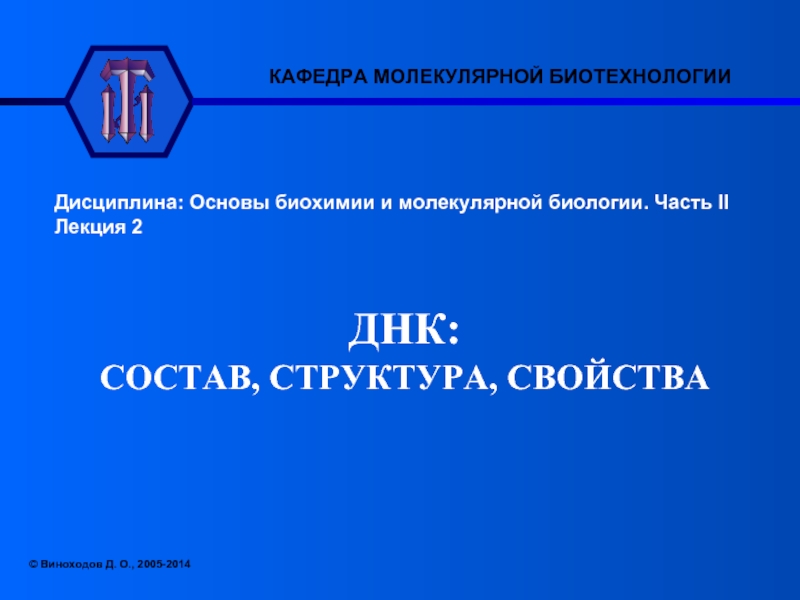- Главная
- Разное
- Дизайн
- Бизнес и предпринимательство
- Аналитика
- Образование
- Развлечения
- Красота и здоровье
- Финансы
- Государство
- Путешествия
- Спорт
- Недвижимость
- Армия
- Графика
- Культурология
- Еда и кулинария
- Лингвистика
- Английский язык
- Астрономия
- Алгебра
- Биология
- География
- Детские презентации
- Информатика
- История
- Литература
- Маркетинг
- Математика
- Медицина
- Менеджмент
- Музыка
- МХК
- Немецкий язык
- ОБЖ
- Обществознание
- Окружающий мир
- Педагогика
- Русский язык
- Технология
- Физика
- Философия
- Химия
- Шаблоны, картинки для презентаций
- Экология
- Экономика
- Юриспруденция
Photosynthesis презентация
Содержание
- 1. Photosynthesis
- 2. Photosynthesis Anabolic (small molecules combined) Endergonic (stores
- 3. Question: Where does photosynthesis take place?
- 4. Plants Autotrophs – produce their own food
- 5. Stomata (stoma) Pores in a plant’s cuticle
- 6. Mesophyll Cell of Leaf Photosynthesis occurs in these cells!
- 7. Chloroplast Organelle where photosynthesis takes place. Thylakoid stacks are connected together
- 8. Thylakoid Grana make up the inner membrane
- 9. Question: Why are plants green?
- 10. Chlorophyll Molecules Located in the thylakoid membranes
- 12. Wavelength of Light (nm)
- 13. Absorption of Light by Chlorophyll wavelength Absorption Chlorophyll absorbs blue-violet & red light best
- 14. Question: During the fall, what causes the leaves to change colors?
- 15. Fall Colors In addition to the chlorophyll
- 16. Redox Reaction The transfer of one or
- 17. Oxidation Reaction The loss of electrons from
- 18. Reduction Reaction The gain of electrons to a substance or the loss of oxygen.
- 19. Question: Why do cells use for energy?
- 20. Energy for Life on Earth Sunlight is
- 21. Structure of ATP ATP stands for adenosine
- 22. Removing a Phosphate from ATP Breaking the
- 23. High Energy Phosphate Bond
- 24. FREE PHOSPHATE can be re-attached to ADP reforming ATP Process called Phosphorylation
- 25. Phosphorylation
- 26. Parts of Photosynthesis
- 27. Two Parts of Photosynthesis Two reactions make
- 28. Two Parts of Photosynthesis 2. Calvin Cycle
- 29. Light Reaction (Electron Flow) Occurs in the
- 30. Cyclic Electron Flow Occurs in the thylakoid
- 31. Cyclic Electron Flow Pigments absorb
- 32. Noncyclic Electron Flow Occurs in the thylakoid
- 33. Noncyclic Electron Flow H2O is split in
- 34. Noncyclic Electron Flow ADP + →
- 35. Chemiosmosis Powers ATP synthesis Takes place across
- 36. Chemiosmosis
- 37. Calvin Cycle Carbon Fixation (light independent reaction)
- 38. Chloroplast
- 39. Calvin Cycle (C3 fixation)
- 40. Calvin Cycle Remember: C3 = Calvin Cycle
- 41. Photorespiration Occurs on hot, dry, bright days
- 42. Photorespiration Because of photorespiration, plants have special
- 43. C4 Plants Hot, moist environments 15% of
- 44. C4 Plants
- 45. CAM Plants Hot, dry environments 5% of
- 46. CAM Plants
- 47. Question: Why do CAM plants close their stomata during the day?
- 48. Cam plants close their stomata in the hottest part of the day to conserve water
Слайд 2Photosynthesis
Anabolic (small molecules combined)
Endergonic (stores energy)
Carbon dioxide (CO2) requiring process that
uses light energy (photons) and water (H2O) to produce organic macromolecules (glucose).
6CO2 + 6H2O → C6H12O6 + 6O2
6CO2 + 6H2O → C6H12O6 + 6O2
Слайд 4Plants
Autotrophs – produce their own food (glucose)
Process called photosynthesis
Mainly occurs in
the leaves:
a. stoma - pores
b. mesophyll cells
a. stoma - pores
b. mesophyll cells
Слайд 5Stomata (stoma)
Pores in a plant’s cuticle through which water vapor and
gases (CO2 & O2) are exchanged between the plant and the atmosphere.
Found on the underside of leaves
Stoma
Слайд 7Chloroplast
Organelle where photosynthesis takes place.
Thylakoid stacks are connected together
Слайд 10Chlorophyll Molecules
Located in the thylakoid membranes
Chlorophyll have Mg+ in the center
Chlorophyll
pigments harvest energy (photons) by absorbing certain wavelengths (blue-420 nm and red-660 nm are most important)
Plants are green because the green wavelength is reflected, not absorbed.
Plants are green because the green wavelength is reflected, not absorbed.
Слайд 13Absorption of Light by Chlorophyll
wavelength
Absorption
Chlorophyll absorbs blue-violet & red light best
Слайд 15Fall Colors
In addition to the chlorophyll pigments, there are other pigments
present
During the fall, the green chlorophyll pigments are greatly reduced revealing the other pigments
Carotenoids are pigments that are either red, orange, or yellow
During the fall, the green chlorophyll pigments are greatly reduced revealing the other pigments
Carotenoids are pigments that are either red, orange, or yellow
Слайд 16Redox Reaction
The transfer of one or more electrons from one reactant
to another
Two types:
1. Oxidation is the loss of e-
2. Reduction is the gain of e-
Two types:
1. Oxidation is the loss of e-
2. Reduction is the gain of e-
Слайд 17Oxidation Reaction
The loss of electrons from a substance or the gain
of oxygen.
Carbon dioxide
Water
Oxygen
Слайд 20Energy for Life on Earth
Sunlight is the ULTIMATE energy for all
life on Earth
Plants store energy in the chemical bonds of sugars
Chemical energy is released as ATP during cellular respiration
Plants store energy in the chemical bonds of sugars
Chemical energy is released as ATP during cellular respiration
Слайд 21Structure of ATP
ATP stands for adenosine triphosphate
It is composed of the
nitrogen base ADENINE, the pentose (5C) sugar RIBOSE, and three PHOSPHATE groups
The LAST phosphate group is bonded with a HIGH ENERGY chemical bond
This bond can be BROKEN to release ENERGY for CELLS to use
The LAST phosphate group is bonded with a HIGH ENERGY chemical bond
This bond can be BROKEN to release ENERGY for CELLS to use
Слайд 22Removing a Phosphate from ATP
Breaking the LAST PHOSPHATE bond from ATP,
will ---
Release ENERGY for cells to use
Form ADP
Produce a FREE PHOSPHATE GROUP
Release ENERGY for cells to use
Form ADP
Produce a FREE PHOSPHATE GROUP
Слайд 27Two Parts of Photosynthesis
Two reactions make up photosynthesis:
1.Light Reaction or Light
Dependent Reaction -
Produces energy from solar power (photons) in the form of ATP and NADPH.
Produces energy from solar power (photons) in the form of ATP and NADPH.
SUN
Слайд 28Two Parts of Photosynthesis
2. Calvin Cycle or Light
Independent Reaction
Also called Carbon Fixation or C3 Fixation
Uses energy (ATP and NADPH) from light reaction to make sugar (glucose).
Also called Carbon Fixation or C3 Fixation
Uses energy (ATP and NADPH) from light reaction to make sugar (glucose).
Слайд 29Light Reaction (Electron Flow)
Occurs in the Thylakoid membranes
During the light reaction,
there are two possible routes for electron flow:
A. Cyclic Electron Flow
B. Noncyclic Electron Flow
A. Cyclic Electron Flow
B. Noncyclic Electron Flow
Слайд 30Cyclic Electron Flow
Occurs in the thylakoid membrane.
Uses Photosystem I only
P700 reaction
center- chlorophyll a
Uses Electron Transport Chain (ETC)
Generates ATP only
ADP + ATP
Uses Electron Transport Chain (ETC)
Generates ATP only
ADP + ATP
Слайд 31Cyclic Electron Flow
Pigments absorb light energy & excite e- of
Chlorophyll a to produce ATP
Слайд 32Noncyclic Electron Flow
Occurs in the thylakoid membrane
Uses Photosystem II and Photosystem
I
P680 reaction center (PSII) - chlorophyll a
P700 reaction center (PS I) - chlorophyll a
Uses Electron Transport Chain (ETC)
Generates O2, ATP and NADPH
P680 reaction center (PSII) - chlorophyll a
P700 reaction center (PS I) - chlorophyll a
Uses Electron Transport Chain (ETC)
Generates O2, ATP and NADPH
Слайд 33Noncyclic Electron Flow
H2O is split in PSII & ATP is made,
while the energy carrier NADPH is made in PSI
Слайд 34Noncyclic Electron Flow
ADP + → ATP
NADP+ + H
→ NADPH
Oxygen comes from the splitting of H2O, not CO2
H2O → 1/2 O2 + 2H+
Oxygen comes from the splitting of H2O, not CO2
H2O → 1/2 O2 + 2H+
P
Слайд 35Chemiosmosis
Powers ATP synthesis
Takes place across the thylakoid membrane
Uses ETC and ATP
synthase (enzyme)
H+ move down their concentration gradient through channels of ATP synthase forming ATP from ADP
H+ move down their concentration gradient through channels of ATP synthase forming ATP from ADP
Слайд 37Calvin Cycle
Carbon Fixation (light independent reaction)
C3 plants (80% of plants on
earth)
Occurs in the stroma
Uses ATP and NADPH from light reaction as energy
Uses CO2
To produce glucose: it takes 6 turns and uses 18 ATP and 12 NADPH.
Occurs in the stroma
Uses ATP and NADPH from light reaction as energy
Uses CO2
To produce glucose: it takes 6 turns and uses 18 ATP and 12 NADPH.
Слайд 41Photorespiration
Occurs on hot, dry, bright days
Stomates close
Fixation of O2 instead of
CO2
Produces 2-C molecules instead of 3-C sugar molecules
Produces no sugar molecules or no ATP
Produces 2-C molecules instead of 3-C sugar molecules
Produces no sugar molecules or no ATP
Слайд 42Photorespiration
Because of photorespiration, plants have special adaptations to limit the effect
of photorespiration:
1. C4 plants
2. CAM plants
1. C4 plants
2. CAM plants
Слайд 43C4 Plants
Hot, moist environments
15% of plants (grasses, corn, sugarcane)
Photosynthesis occurs in
2 places
Light reaction - mesophyll cells
Calvin cycle - bundle sheath cells
Light reaction - mesophyll cells
Calvin cycle - bundle sheath cells
Слайд 45CAM Plants
Hot, dry environments
5% of plants (cactus and ice plants)
Stomates closed
during day
Stomates open during the night
Light reaction - occurs during the day
Calvin Cycle - occurs when CO2 is present
Stomates open during the night
Light reaction - occurs during the day
Calvin Cycle - occurs when CO2 is present
